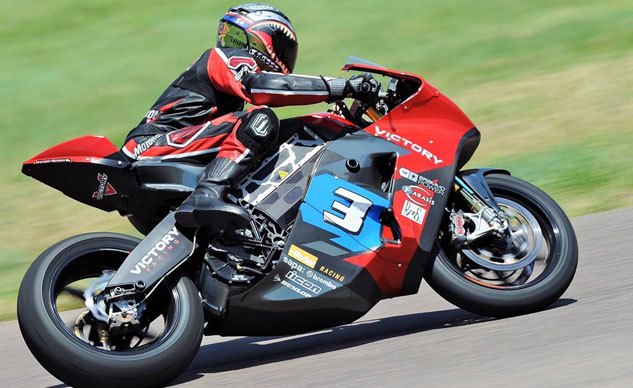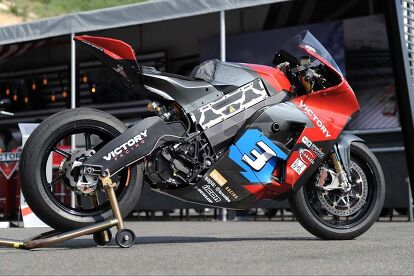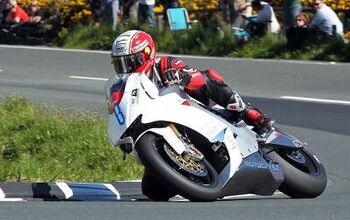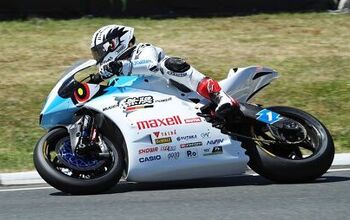Victory Isle of Man TT Zero Racebike Test
Feeling the buzz of electric power
I’m tucked in behind the bubble of an authentic Isle of Man TT racer watching numbers roll past 140 mph on the speedometer, but there’s not even a whisper from the engine. That’s because this Victory doesn’t have an engine – it uses an electric motor.
Victory/Brammo Race Isle of Man TT Zero
Yep, this is the same bike TT ace Lee Johnston rode to a podium finish in the 2015 IoM TT Zero race, lapping the legendary public-road course at an average speed of 111.62 mph. The bike is based on a Brammo that raced the TT Zero in 2014, but it’s been further developed since Victory purchased Brammo’s motorcycle business in January 2015. More info about the changes Victory made to the bike can be found here in Troy Siahaan’s article.
Victory had brought its racebike to High Plains Raceway in Colorado as part of the launch of its new Empulse TT, a streetbike based on the former Brammo Empulse R. The Empulse TT was a fun machine to play with on a racecourse, but its 54 hp is dwarfed by the 120 horses said to be on tap in the racebike’s state of tune that day.
2016 Victory Empulse TT First Ride Review
Lee Johnston was at the Colorado event, and he proved to be a likeable and gregarious racer guaranteed to raise a smile or be cracking one. He said he hadn’t ever ridden an electric-powered motorcycle before the TT races, so he was unsure what to expect. Amazingly, the bike worked well for him right off the truck. All it needed to suit him were some mods to the Ohlins fork: stiffer fork springs, some shim-stack revisions and additional fork oil. No changes were made to the shock.
Swinging a leg over the Victory was a little unusual. It feels significantly taller than the Empulse TT – an extra 6.5kWh of batteries need to be jammed in somewhere. Also, at a stated 485 lbs, it’s on the heavy side for a full-on racebike without any street equipment.
Unlike the Empulse TT, Victory’s racebike doesn’t use a multi-speed transmission – it has just one ratio. Gearing can, of course, be varied via the final drive. A 42-tooth rear sprocket was used when the bike was raced at Laguna Seca as a Brammo; Victory fitted taller gearing, a 39T, at the IoM because of its longer straights. Without a clutch or gears, taking off and accelerating was as easy as a scooter. And I mean that in a good way.
Throttle, er, motor response was intuitive and pleasingly smooth. Dialing in power is as simple as twisting the grip, and it pulls with a relentless lunge that never seems to let up. The only trepidation felt was when adding power while leaned over. An electric motor simply doesn’t have the amount of flywheel mass as an internal-combustion engine, so I worried a sudden loss of grip when applying power might result in an ugly highside – Victory’s machine is raced without a traction-control system. Nevertheless, enough power was able to be laid down on the track’s 2,800-foot straightaway to see 142 mph on the speedo, the Empulse TT could only muster 113 mph.
The High Plains circuit features 2.55 miles of asphalt playfully arranged with more than 300 feet of elevation changes, and the Victory voraciously lapped it up. Turn-in response is much quicker than expected from a sportbike scaling in at almost 500 lbs – credit lightweight forged magnesium wheels from OZ Racing shod with pointy and grippy Dunlop Pro tires.
Also deserving praise is the suspension and brake package. The Brembo radial-mount monoblocks offer terrific feel, and the inverted Ohlins fork provides excellent support during braking. I could see why Johnston was so happy with the bike’s setup at the TT.
Though I only got three laps aboard Victory’s racebike, I learned enough to know the platform is very raceable in its current setup, especially on short circuits where its power can be dialed up near maximum.
“Our Victory electric race bikes are built to compete on tracks like Willow Springs, COTA, or Laguna Seca that don’t have miles and miles of straightaway,” Gary Gray, Product Director Motorcycles and Business Leader for Polaris Electric Motorcycles, told us. “They have amazing cornering speed and are very nimble. They are not massive bikes with huge batteries. They look and feel like a gas sport bike.”
Duke’s Den – Victory Motorcycle’s New Performance Focus
The Victory’s limitation for racing the Isle of Man is its battery capacity. Currently – pun intended – the 16.5 kilowatt-hours isn’t enough to race flat out the entire distance of the TT’s Mountain Course, so the motor’s maximum output can’t be exploited. The bike registered 144 mph on the TT’s Sulby Straight. A few years earlier, the Brammo predecessor was clocked at 170 while racing at Daytona.
“That race (the TT) is all about top speed,” Gray said, “so the fastest electric bikes are really big to carry a lot of battery. To race at the Isle of Man TT and win, a different and much bigger bike would be required.”
Victory Isle of Man TT Zero Racer On A Dragstrip + Video
Gray, as is typical for an OEM rep, was quite cagey with his responses about what the future might offer. Will Victory build a new racer with more batteries for the Isle of Man TT, or will they refine and upgrade the existing bike for racing shorter circuits?
“We do plan to race Victory electric bikes in 2016,” allowed Gray, “but where and how will remain confidential for now.”
Hard to say what Gray is hinting at, but if I were forced to guess, perhaps we’ll see Victory’s e-bike racing up Pikes Peak next year along with its sister, Victory’s Project 156 that showed much promise in this year’s Hillclimb. Johnston told me he’d be up for the challenge if Victory decided to do it.
More by Kevin Duke






















































Comments
Join the conversation
Some day I'll have an electric bike.
But not yet. (shrug)
I really want to like electric bikes, especially the super exotic ones like the lightning. However, my commute is too far (140 highway miles roundtrip), they are too expensive, and they don't suit my riding habits. Sure they would be fine as they are for going back and forth to work in town, ten miles each way, but then why wouldn't I just ride the other bikes I have for that?
For me, and many others I know, the technology just isn't there yet. And for those that it is suited to, it becomes more of a lifestyle choice than a practical one given that ICE bikes are far more accessible and cost effective.